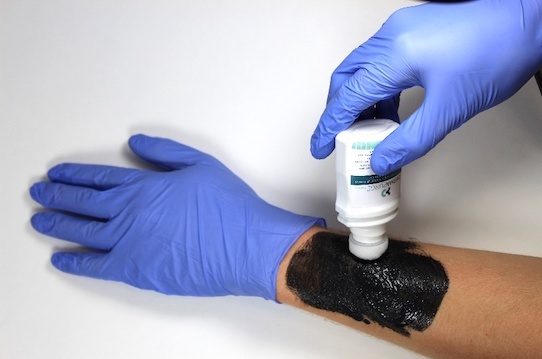Remove dangerous nanoparticles from the skin
Materials with nanoparticles are regarded as a billion-dollar business. However, they can also be dangerous during production. A Dresden startup therefore wants to improve occupational safety.

Dresden. Scratch-resistant paints, dirt-repellent surfaces, fast-curing concrete: materials with nanoparticles are considered a new miracle cure. There is no less than a billion-dollar market waiting for them. Yet there are also dangers lurking. Not so much in the end products such as paint, where the nanoparticles are already bound, but rather in industrial production and research laboratories.
Inflammation in the lungs
Despite standardized, high safety precautions, there is always unintentional contamination of the skin. “The nanoparticles cannot be removed with water and soap or other decontamination agents,” says one of the founders of the Dresden-based startup Derma Purge, Felix Klee (31). That can be dangerous. If the nanoparticles (nano = Greek for dwarf) enter the body, for example through inhalation, there is a possibility that they could cause inflammation in the lungs. Inflammatory structures can in turn lead to cancer.
The background is that particles with a diameter of less than 100 nanometers are about the size of a virus. On the one hand, this gives them a large surface area and at the same time a very low mass, which is what makes the special properties listed at the beginning possible. On the other hand, due to their size the particles are also able to penetrate cell walls.
Water and soap are not enough
To protect workers from these hazards, the Derma Purge team has come up with a solution: “Since nanoparticles can penetrate the skin or be ingested orally by contamination carry-over (e.g. when hands touch the mouth) and thus represent a potential risk to health, rapid and complete removal is of immense importance. This is what motivated us to develop the Derma Purge NANO gel,” says Felix Klee, who is responsible for business management issues in the startup.

In a way, the gel comes into play when the soap fails. Because water and soap dilate the skin pores and thus impair their barrier function, they are unsuitable. According to the startup, however, Derma Purge’s gel should remove almost all particles (more than 99 percent).
Accident gives founders the idea
This was discovered by chemists Jonas Schubert (33) and Max Schnepf (29) – the initiators of the project – as a result of an industrial accident at the Dresden Leibniz Institute of Polymer Research. “The business idea is based on an accident of a student assistant with nanoparticle solution”. At the time, Jonas Schubert and Max Schnepf were working on their doctorate at the institute and had worked with the student assistant.
“Despite the prescribed safety equipment (Technical Rules for Hazardous Substances 527 – Handling of Nanomaterials), the skin of the student assistant behind the glove came into direct contact with nanoparticle solution,” reports Felix Klee. The attempt to clean the affected areas with water, soap and conventional decontamination agents was not successful. However, this was only noticed because the tiny particles became visible under UV light. “Neither doctors nor the poison emergency call could give recommendations for decontamination. This was the decisive reason for us to take a closer look at the problem,” says Klee.
Product to be launched in 2021
Derma Purge intends to manufacture the nano-kit itself and distribute it to research institutions and industry. The market entry is planned for 2021. Currently, the startup is still financed by an EXIST grant. In the second quarter of next year a business angel wants to join Derma Purge according to the responsible persons.
Currently the founders do not see any comparable solutions on the market. To protect the invention, the Leibniz Institute in Dresden has applied for a patent for the gel. “There is no product solution on the market that can effectively remove nanoparticles from the skin,” says Felix Klee, who sees an estimated market potential of 16 million euros in Europe and the USA alone.

